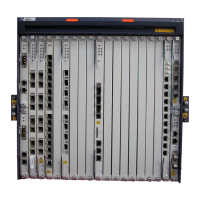
 Loading...
Loading...
Do you have a question about the Zte ZXA10 C300 and is the answer not in the manual?
| Model | ZXA10 C300 |
|---|---|
| Manufacturer | ZTE |
| Humidity | 5% to 95% (non-condensing) |
| Uplink Ports | 2 x 10GE |
| Supported Standards | IEEE 802.3ah, ITU-T G.984.x |
| GPON Ports per card | 8 |
| EPON Ports per card | 8 |
| Ports | GPON/EPON ports |
| Storage Temperature | -40°C to +70°C |
| Dimensions | 482.6 mm |
Defines GPON ONU types, including default ZTE types and XG-PON.
Describes the process of authenticating GPON ONUs using SN authentication.
Configures T-CONT bandwidth profiles for upstream traffic control and QoS.
Covers configuring P2P service, which uses Ethernet interfaces for data, multicast, and VoIP.
Configures QoS on Ethernet interfaces, including CoS, DSCP, and traffic shaping.
Manages QoS on the OLT interface, covering queue scheduling and mapping.
Sets QoS parameters on ONU interfaces, including trust precedence and CoS remarking.
Configures the device to act as a DHCP server for allocating IP addresses to users.
Configures Type B PON protection for dual PON port backup, ensuring service continuity.
Prevents MAC address spoofing by constraining MAC learning and reporting move events.
Prevents illegal users from accessing the Internet by filtering traffic based on IP/MAC binding.
Configures Secure Shell (SSH) for secure remote login, encrypting data transmission.
Covers basic MPLS configuration, including loopback interfaces, VLANs, and routing protocols.
Provides Ethernet-based multipoint-to-multipoint communication over IP/MPLS networks.
Enables Ethernet-based point-to-point communication over IP/MPLS networks using VLLs.
Emulates native services over Packet Switched Networks (PSNs) using Pseudo-Wires (PWs).
Enhances MPLS network stability and reliability through PW redundancy in 1:1 or 1+1 modes.
Supports service layer OAM functions like link continuity check and loopback detection.